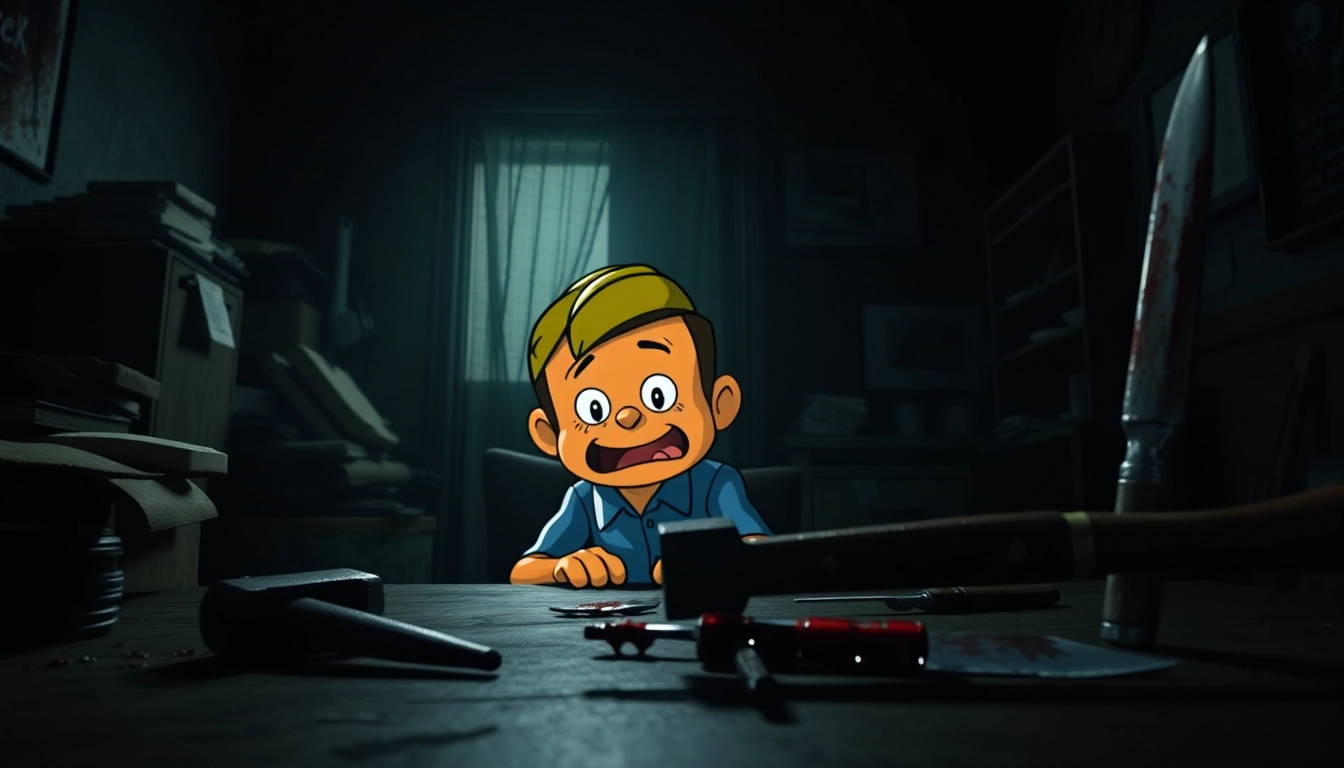Overview and Context: BloodMoney – A Dark Psychological Clicker Experience
In the realm of psychological horror games, few titles delve as deeply into moral ambiguity and human nature as blood money. This dark clicker game challenges players to confront uncomfortable questions about survival, morality, and the human capacity for cruelty. Set against the backdrop of a desperate situation, BloodMoney offers a visceral experience where every click not only accumulates wealth but also chips away at the player’s moral integrity. The game’s core mechanic revolves around clicking on a cheerful, seemingly innocent character named Harvey, whose suffering intensifies with each interaction, creating a disturbing dichotomy between profit and pain.
Game Mechanics and Gameplay Overview
Clicking Mechanics
At the heart of BloodMoney lies its simple yet haunting clicking mechanic. The player must click on Harvey, a bright and cheerful character, to generate money—initially just a dollar per click. However, as the urgency of acquiring $25,000 for medical bills intensifies, the temptation to click rapidly increases. Each click not only boosts the player’s cash reserve but also inflicts pain upon Harvey, whose reactions range from subtle discomfort to overt suffering. The game cleverly employs visual cues—Harvey’s facial expressions, posture, and dialogue—to depict his escalating torment, subtly forcing players to question the morality of their actions.
Upgrade System and Tools
As the game progresses, players can purchase upgrades from an in-game shop to maximize earnings. These tools range from benign items like pillows and needles to increasingly violent weapons such as scissors, knives, and hammers. Each upgrade amplifies the amount of money earned per click but at a growing cost to Harvey’s well-being. The game’s design ensures that each upgrade is psychologically impactful—visuals become more disturbing, and Harvey’s demeanor shifts from cheerful to terrified, embodying the moral toll of the player’s choices.
Multiple Pathways and Strategic Choices
BloodMoney isn’t linear; it offers multiple pathways that influence both the narrative and the ending. Players can choose to minimize Harvey’s suffering, opting for less violent tools, or aggressively pursue profit regardless of the human cost. These choices are not just cosmetic—they shape the game’s ending, revealing different facets of morality and human nature. The strategic element lies in balancing the urgency of reaching the financial goal with the ethical implications of each upgrade.
The Dark Narrative of BloodMoney and Harvey
The Desperate Situation
The protagonist is faced with a harrowing dilemma: a serious medical diagnosis requires $25,000 for treatment—a sum they do not possess. With time running out, the game introduces Harvey as a bizarre yet compelling solution. Harvey, a cheerful and seemingly harmless character, offers to help generate income through clicks. It appears innocent initially, but as the player continues, the narrative darkens, revealing the true cost of survival: Harvey’s pain and suffering.
Harvey’s Proposition and Moral Descent
Harvey’s offer is simple yet disturbing: click on him to earn money. The game portrays him as an oblivious, friendly figure—his innocence contrasted sharply with the violent tools available in the shop. As players purchase tools like needles, scissors, and hammers, Harvey’s reactions become more visceral. Subtle details suggest Harvey may not fully comprehend what’s happening; his surprise at more violent weapons implies innocence or ignorance, adding a complex layer to the moral dilemma. Are we exploiting a naive character, or are we simply desperate?
Visual and Psychological Horror
BloodMoney masterfully uses visual cues to amplify its horror. Harvey’s appearance deteriorates over time, his expressions become more pained, and his dialogue shifts from cheerful to pleading. The game’s artistic design evokes discomfort, leveraging unsettling imagery and sound effects to immerse players in a psychological nightmare. The progression from harmless clicking to violent exploitation mirrors the descent into moral depravity, forcing players to confront their own limits.
Player Choices and Multiple Endings
Three Paths, Three Endings
The culmination of gameplay hinges on the player’s moral choices—whether they choose to minimize Harvey’s suffering or maximize profit at any cost. These decisions lead to three distinct endings:
- The Good Ending: Achieved by limiting violence, using minimal harmful tools like scissors, and showing mercy to Harvey. This ending reflects moral integrity and compassion, emphasizing that survival doesn’t have to come at the expense of humanity.
- The Normal Ending: A balanced approach, utilizing tools like the needle, which causes moderate pain but avoids the extremes. This pathway demonstrates compromise—survival at a moral crossroads.
- The Bad Ending: Maxed-out violence, employing weapons like hammers and knives, leading to Harvey’s intense suffering. This route symbolizes moral decay and greed, ultimately resulting in a darker conclusion that questions the player’s ethics.
Uncovering the Hidden Depths
Beyond the surface, BloodMoney offers subtle storytelling elements. Harvey’s reactions, dialogue, and the shop’s inventory subtly hint at a deeper narrative—possibly reflecting broader themes of exploitation, innocence corrupted, and the human condition under duress. Observant players notice that Harvey is surprised by the violent tools, suggesting a lack of awareness or complicity, which complicates the moral landscape further.
Community Insights and Player Reactions
Player Perspectives and Discussions
The BloodMoney community is vibrant, with players sharing their experiences, strategies, and moral reflections. Many report feeling genuine emotional distress when Harvey reacts to pain, highlighting the game’s emotional potency. Some players attempt to reach the good ending with minimal violence, while others challenge themselves to see how far they can push the moral boundaries before the game’s ending shifts.
Videos and Gameplay Analyses
Featured gameplay videos demonstrate various approaches—some players focus on rapid clicking, maximizing profit at the expense of Harvey’s suffering, while others deliberately choose less violent upgrades. These videos serve as valuable guides, illustrating how different choices influence the narrative and ending. Content creators often highlight the game’s psychological horror elements, emphasizing its capacity to evoke empathy and moral reflection.
The Psychological Impact: Testing Morality Under Pressure
Emotional Design and Player Reflection
BloodMoney’s emotional design is intentionally intense. The visual deterioration of Harvey, coupled with his dialogue and reactions, evoke feelings of guilt, empathy, and discomfort. The game forces players to question whether they are merely clicking or actively participating in a moral breach. It’s an exploration of human nature—how far does desperation push us toward evil? Many players report feeling genuinely disturbed, even after turning off the game, reflecting on their choices and the nature of morality.
Time Pressure and Urgency
The ticking clock to gather $25,000 adds a layer of urgency, amplifying stress and decision-making. The mental pressure to optimize clicks while balancing moral considerations creates a psychologically charged environment. This pressure mirrors real-life situations where individuals face difficult choices under time constraints, making BloodMoney a compelling simulation of moral stress.
Comparing BloodMoney to Other Dark Clicker and Horror Games
Unique Features and Innovations
While many clicker games focus on incremental growth and reward, BloodMoney distinguishes itself with its narrative depth and moral complexity. Unlike typical idle games, it emphasizes emotional engagement, visual storytelling, and ethical dilemmas. Its unsettling atmosphere and focus on moral descent set it apart from other dark-themed games like “Don’t Forget” or “HITMAN” series, which explore violence and morality through different mechanics.
Influences and Similar Titles
BloodMoney shares thematic elements with psychological horror titles and narrative-driven games that challenge players’ ethics. Its emphasis on visual storytelling and moral choices echoes titles like “Spec Ops: The Line” or “Papers, Please,” which confront players with ethical dilemmas under pressure. However, its unique clicker mechanic and focus on suffering as a means of profit make it a distinctive experience in the genre.
Conclusion: When Survival Comes at What Cost?
BloodMoney is more than just a dark clicker game; it’s a psychological mirror reflecting our instincts when faced with life-and-death situations. The game masterfully combines minimalist gameplay with profound moral questions, forcing players to confront their own boundaries. Are we inherently good, or does desperation reveal our darker sides? Each decision, each click, pushes Harvey closer to suffering or salvation, culminating in one of three endings that reveal the true cost of survival.
As you navigate this disturbing world, remember that every choice echoes beyond the game. The experience challenges us to consider how far we’re willing to go for ourselves and others. Will you choose mercy, moderation, or relentless pursuit of profit? The answers lie within your moral compass—test it wisely.
For those intrigued by the dark depths of human morality, BloodMoney offers a haunting journey worth exploring. Discover more about this unsettling experience and deepen your understanding of the game’s themes by visiting blood money. Remember, in this game, as in life, survival often comes at a profound moral cost.

